On the morning of 12 February 1554, a petite girl of seventeen, with sandy-red hair and intelligent, sparkling brown eyes, stood awaiting her death on a scaffold by the White Tower in the Tower of London. Her ladies, Mistress Allan and Elizabeth Tilney, wept by her side but she remained composed and focused on her prayers. Her name was Lady Jane Grey and her story is as heart-rending as they come.
In May 1553, Jane’s ambitious father arranged for her to marry Lord Guildford Dudley, the son of John Dudley, Duke of Northumberland, one of the most powerful men in England.
Not long after, as the teenaged Edward VI lay on his deathbed, he named his beloved cousin, the Protestant Jane Grey, his successor, rather than his Catholic sister, Mary Tudor.
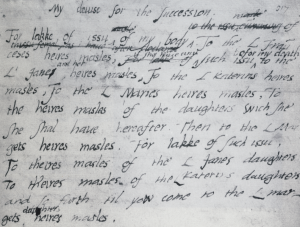
Edward VI’s “devise for the succession”, 1553, written in his own hand. In the fourth line, Edward has changed “L Janes heires masles” to “L Jane and her heires masles”.
On 9 July, three days after Edward’s death, Jane was informed that she had been named Edward’s heir and was persuaded to accept the throne, officially proclaimed queen the very next day.
Her reign was short-lived, as Mary Tudor was proclaimed rightful queen on 19 July amid popular rejoicing and Jane and her husband, Guildford Dudley, imprisoned in the Tower of London, charged with treason. In November, they were condemned to death but it was largely believed that Queen Mary would pardon Jane, as it was clear that she was a victim of ruthless and ambitious men.
However in January 1554, Jane’s father joined a rebellion that intended to prevent Mary’s marriage to Philip of Spain and replace Mary with her half-sister, Elizabeth – and although Jane had no knowledge of the rebellion – her fate was sealed and all possibilities of a pardon shattered.
On the morning of 12 February 1554, Jane watched as her young husband was led from the Beauchamp Tower to his place of execution on Tower Hill.
Now, dressed in a black gown and carrying an open prayer book, it was Jane’s turn. She followed the Lieutenant of the Tower, Sir John Bridges, to the scaffold and having mounted the steps turned to address the crowd:
‘Good people, I am come hither to die, and by a law I am condemned to the same. The fact, indeed, against the queen’s highness was unlawful, and the consenting thereunto by me: but touching the procurement and desire thereof by me or on my behalf, I do wash my hands thereof in innocency, before God, and the face of you, good Christian people, this day’. (Chronicle of Queen Jane and of Two Years of Queen Mary.)
She then wrung her hands, still holding her prayer book and continued:
‘I pray you all, good Christian people, to bear me witness that I die a true Christian woman, and that I look to be saved by none other means, but only by the mercy of God in the merits of his only son, Jesus Christ: and I confess, when I did know the word of God I neglected the same, love myself and the world, and therefore this plague or punishment is happily and worthily happened unto me for my sins; and yet I thank God of his goodness that he has thus given me time and respect to repent.’ (De Lisle, Pg. 151)
Jane then asked the people gathered to assist her with her prayers ‘while I am alive’. She would have no prayers said for the dead, a clear demonstration of her faith.
After kneeling down she recited the psalm of Miserere mei Deus in English and then stood and gave her gloves and handkerchief to Elizabeth Tilney and her prayer book to Thomas Bridges, the brother of the Lieutenant of the Tower.
The executioner stepped forward to help Jane untie her gown but she ordered him to leave her, preferring, of course, the help of her ladies. After removing her gown, headdress and neckerchief, the executioner knelt and asked for Jane’s forgiveness, which she ‘most willingly’ gave.
Jane was then directed to stand on the straw and there, for the first time, saw the block. One can only imagine the fear that must have surged through her small body at the sight of it. She turned to the executioner and said, ‘I pray you dispatch me quickly.’ Then knelt down and asked, ‘Will you take it off before I lay me down?’ To which he responded, ‘No, madame.’
By this stage Jane’s ladies were too distressed to blindfold their mistress and so Jane was left to perform this final task herself.
Now plummeted into darkness, she began to feel for the block. Unable to locate it she panicked and cried out, what shall I do? Where is it? But no one – not her ladies, nor the officials, nor the executioner – moved to help her. They were all as though frozen by the heartbreaking and pitiful scene that was unfolding before them.
Finally, an onlooker—possibly, someone in the crowd—appalled by what was taking place, guided her to the block.
There she laid her head in the curved aperture, stretched out her body and said loudly: ‘Lord, into thy hands I commend my spirit!’
With one swing of the axe, the sparkle was extinguished – it was done.
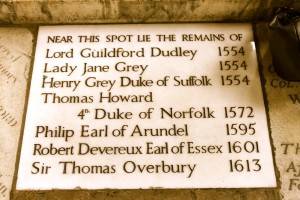 A contemporary of Jane’s recorded having seen ‘her half-naked corpse still lying on the scaffold later that day and commented on the extraordinary amount of blood which had issued from so small a body.’ (Plowden, Pg. 164)
A contemporary of Jane’s recorded having seen ‘her half-naked corpse still lying on the scaffold later that day and commented on the extraordinary amount of blood which had issued from so small a body.’ (Plowden, Pg. 164)
Sometime before nightfall, Jane’s remains were buried in the Chapel of St Peter ad Vincula near to those of her husband and two other fallen Tudor queens, Anne Boleyn and Catherine Howard.
Eleven days later, Jane’s father, Henry Grey, met the same gruesome end and was buried near his daughter and son-in-law – a tragic family reunion.
Sources The Executions of Lady Jane Grey and Lord Guildford Dudley Chapman, H. W. Lady Jane Grey, 1962. De Lisle, L. The Sisters Who Would Be Queen: The Tragedy of Mary, Katherine & Lady Jane Grey, 2008. Plowden, A. Lady Jane Grey: Nine Days Queen, 2003. Weir, A. Traitors of the Tower, 2010.
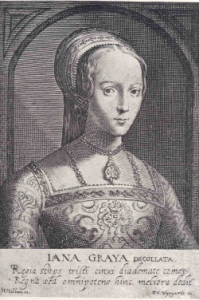
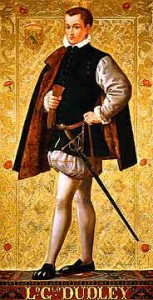
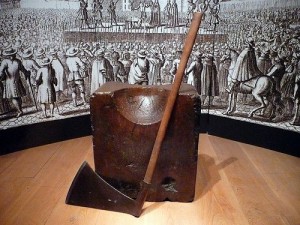
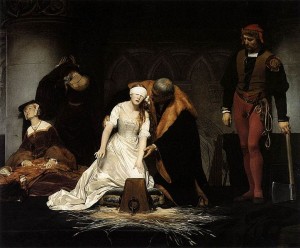















There doesn’t seem to be an awful lot of difference between Lady Jane and Catherine Howard really, if you discount the level of intelligence and moral behaviour of the two girls…to me anyway.
Both seem to be pawns in the game of power played by the men in their families, both were struck down so young, no more than children really, as the consequence when these plans failed, and both disregarded in death as in life, just thrown into a shallow grave under the flag stones of the Chapel, and forgotten about…the ‘out of sight, out of mind’ mentality, it is so sad. But at least they are slowly being given back their dignity and/or their recognition in history with the modern historians and their more indepth research.
It must have been heart breaking seeing her trying to find the place to lay her head for the final time. She died so bravely, for one so young.
I nearly reached for a tissue (yet again). This sad story gets me every time. Poor Jane, what terror she must have felt. The residual energy must linger everywhere at the tower.
Jane was Not a Traitor–not in the most true-sense of the word. She was a Martyr, a stronger and braver soul than even Princess Elizabeth; Jane’s testimony of withstanding repeated-intrusions and harassments by the Roman-Catholic priests that Queen Mary sent against her is a powerful-reminder that to remain Faithful to JESUS above-all and before any church fulfills the Heart of a True Believer in JESUS.
Jane Grey may not have been a traitor in the true sense of the word, but she was not a martry. This is a myth spread by the martyrtologist John Fox. She didn’t die for her faith. Yes, she had a true Christian faith, so did Queen Mary. She was on the verge of being pardoned and released when her idiot father took part in a second rebellion, six months after he was forgiven by Mary for putting Jane on the throne in the first place. Had Henry Grey, Duke of Suffolk not tried to put Elizabeth on the throne, it is likely that Jane, already condemned would have been spared. She had been tried in November with her husband and others, but had been given more freedom, usually a sign of coming pardon. She and Dudley were executed the following February 1554, over six month since her occupation of the throne. Although Jane was reluctant at first, within one day she was giving orders. She acted in her own agency and believed that God had called her to the crown, given to her via Edward in his Devise and Letters Patent. She gave orders to the council, to the nobles, to the army, to the navy, to her husband, who she refused to crown, she took over the keys in the Tower and locked herself and the council in, she had command of the arms and she called Mary illegal. Mary gained daily more support and was thus successful as everyone abandoned Jane, including her father. Mary still saw her as a pawn. However, the second rebellion sadly sealed her fate and Mary could not let her live as she would be a constant threat. The death sentence was thus enacted. However, even on the scaffold Jane showed inner strength and composure, the Victorian painting is a myth. Her letters show a woman of courage and calling her a martyr or victim does not do her justice. This was a struggle for a crown by two strong and brave women. Mary’s life and freedom were under threat, she had to flee in the middle of the night and she was cornered in East Anglia. She had local but popular support. Due to her being believed to have the lawful claim and her own strong stand, people flocked to her, changed sides and nine days later (13 in total) in a bloodless coup, Mary was finally Queen. She could have saved Jane had she changed to the Catholic faith because then she would not be a focus for Protestant extremists who dreamed of a Protestant paradise like Thomas Wyatt the Younger. However, Jane showed herself true to her own principles, as straunch in her own belief as Mary was and in fact she too was a fanatic, probably even more so, because she did not convert. Doctor Freckenham was very impressed by her and her learning and he said so. He stayed with her at her own request at the end.
Her death was tragic because she was only seventeen, was well educated and had so much potential. However, she was not an innocent victim, even if she was not either traitor or martyr either.
It is sad so many were brainwashed, and innocent victims of circumstances. Mary was the rightful heir to the throne of England, Her half brother Edward defied his father’s King Henry VIII’s will and testament. Edward was the one wanting to destroy the Catholics, by naming Jane Grey as successor to the throne of England; he believed she would carry his deed, and continue in his fanatical approach, however I think the whole lot of them suffered psychologically. Sad.
If anyone is interested, I have an essay that tells just what will become of Jane Grey-Dudley in the future. It’s prophetic because the words were given to me one night many months ago while I was feeling sad about what happened on February 12 1554. It’s a prophetic-revelation of hope concerning Jane and her family and fellow-believers who chose JESUS in their lives. E-mail me if You would like to read about it and/or give any criticisms or comments.
Very sad poor girl, God give her peace !
Much of the quotations come from Foxe’s Book of Martyrs (John Foxe 1516- 1567).
These poor souls who faced the block to meet their deaths did so with such amazing courage. I really do not know how they managed this with such calm. It is truly such a horrible way to die. We hear of their placid conduct at their last moments of life. Just the very sight of that block would conjure up such terror and enormous fear. It is a shocking death that can quite easily go wrong as it did for Mary Queen of Scots. It took numerous strikes with the axe to sever her head. Where did they get this bravery and courage to deal with this? Then there was the punishment to be hanged drawn and quartered. Unbelievably cruel. Anne Boelyn was removed because she could not produce a male heir. So she was “set up” on trumped up charges to get rid of her. Henry’s affections had moved to Jane Seymour. So many were murdered in this process. Cromwell was behind all of this. Eventually he had a date with the block himself. No one was safe in this environment in those days. l can only imagine the terror the victims faced at their time of death at the block, but they did not show it.
They were such religions fanatics–some of them hearing Mass several times a day (that’s ‘cra-cra)–and when they knew there was no longer a chance to get out of it, they resigned themselves. The only one I remember having a particularly bad time of it was Jane’s involuntary husband, Guildford. He requested to see Jane one last time in jail, but she sent back a message telling him to buck up and face it. She had to watch them carry his body and severed head past her cell before getting her own turn. But I certainly agree, having to know your fate and make a SPEECH! They really had to know they would end up in a better place. Only that one guy Guildford cried and carried on a bit, but to no avail. Chunk!